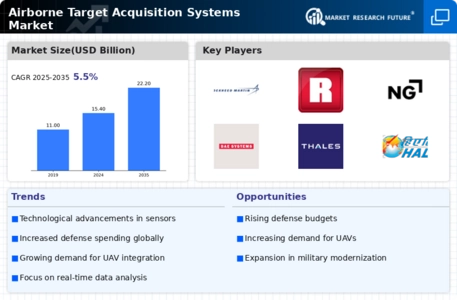Rising Military Expenditures
In recent years, there has been a marked increase in military expenditures across various nations, which is significantly impacting the Airborne Target Acquisition Systems Market. Countries are investing heavily in modernizing their defense capabilities, with a focus on enhancing surveillance and reconnaissance operations. For instance, military budgets in regions such as Asia-Pacific and Europe have seen substantial growth, with some nations allocating over 10% of their defense budgets to advanced technology systems. This trend indicates a strong demand for airborne target acquisition systems, as military forces seek to improve their operational readiness and effectiveness in various combat scenarios.
Growing Focus on Border Security
The Airborne Target Acquisition Systems Market is also being driven by an increasing emphasis on border security and surveillance. Governments are recognizing the need to monitor and secure their borders more effectively, leading to a surge in demand for airborne systems capable of providing real-time intelligence. This focus on border security is particularly evident in regions facing geopolitical tensions, where nations are investing in advanced surveillance technologies. As a result, the market for airborne target acquisition systems is expected to expand, with projections indicating a compound annual growth rate of approximately 5% over the next five years, reflecting the growing importance of aerial surveillance in national security.
Emerging Threats and Asymmetric Warfare
The evolving landscape of warfare, characterized by emerging threats and asymmetric warfare tactics, is significantly influencing the Airborne Target Acquisition Systems Market. As military operations adapt to counter unconventional threats, there is a growing need for advanced target acquisition systems that can operate effectively in diverse environments. This shift is prompting defense organizations to invest in systems that offer enhanced capabilities for detecting and engaging non-traditional targets. The market is expected to respond to these changing dynamics, with an anticipated increase in demand for systems that can provide real-time data and support decision-making in complex operational scenarios.
Technological Advancements in Sensor Technology
The Airborne Target Acquisition Systems Market is experiencing a notable transformation due to rapid advancements in sensor technology. Enhanced sensors, including electro-optical and infrared systems, are becoming increasingly sophisticated, allowing for improved target detection and tracking capabilities. These advancements are likely to enhance the operational effectiveness of airborne systems, making them more appealing to military and defense sectors. According to recent data, the integration of advanced sensors is projected to increase the accuracy of target acquisition by up to 30%. This trend suggests that as technology continues to evolve, the demand for advanced airborne target acquisition systems will likely rise, driving growth in the market.
Integration with Unmanned Aerial Vehicles (UAVs)
The integration of airborne target acquisition systems with unmanned aerial vehicles (UAVs) is emerging as a significant driver in the Airborne Target Acquisition Systems Market. UAVs equipped with advanced target acquisition systems are increasingly being utilized for reconnaissance and surveillance missions, providing military forces with enhanced situational awareness. The market for UAVs is projected to grow at a compound annual growth rate of around 15%, indicating a robust demand for systems that can be seamlessly integrated with these platforms. This trend suggests that as UAV technology continues to advance, the need for compatible airborne target acquisition systems will likely increase, further propelling market growth.


















Leave a Comment